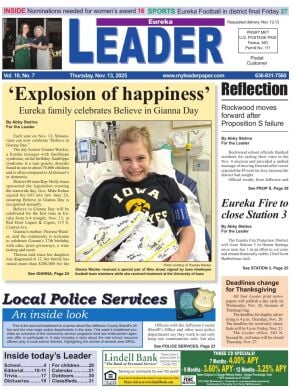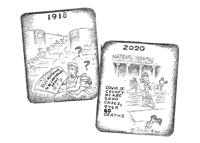Editor’s note: This column was written before President Donald Trump was stricken by the virus. May he and Gov. Mike Parson and their wives recover quickly, without health repercussions.
Approximately nine months into the worst health crisis of our collective lives, there remain some fortunate people in our county and country.
A blessed few, more in some regions than others, can still say they themselves have not contracted COVID-19, nor do they personally know anyone who has been stricken with it or died from it, or its complications.
In September, a Dittmer woman wrote the Leader she knew of no one whose health had been affected.
Not so, me.
My circle includes at least 10 people who have caught and recovered from the virus, including a high school classmate and a longstanding church friend, both of whom were both brought back from the brink of death.
My brother ran a nearly 104-degree temperature in his encounter with the virus, and my brother-in-law had a nasty turn with it, as did my son-in-law’s uncle.
Still, I didn’t personally know any of the more than 200,000 Americans who have died. Until last week. Someone who crossed my professional path a few times over my newspapering career is now among the dead.
Among other points, the Dittmer letter writer questioned whether the virus is real and wondered what to believe about it, given the contradictory national talking points.
Trust me, ma’am, although it’s hard to sort through the claims and counterclaims, this crisis is, most assuredly, real.
That last sentence constitutes fightin’ words to a portion of Leader readers. Every time the newspaper posts a story to our website and social media pages updating the county’s caseload and death statistics, as reported by the Jefferson County Health Department, some folks get angry.
They insist there is no crisis and that the media, in general, and the Leader, in particular, are simply trying to scare people to serve underlying political motives.
Here’s the truth from Leader World Headquarters: We are journalists doing our jobs. And we do have a motive – to inform.
Did you know that was something newspapers refused to do during the influenza pandemic of 1918-1920?
World War I was President Woodrow Wilson’s all-consuming focus at that time. The government and an enabling press conspired to hush up the influenza scourge, believing the truth would undermine the war effort.
That did happen, in an unpredictable, but devastating way. More on that later.
The head-in-the-sand strategy back then contributed to the staggering death toll – an estimated 675,000 American lives.
Public ignorance led to horrible decision-making – and death. The bodies piled up first at army camps – where scientific advice was ignored – then in urban areas, and finally all over the country. The pandemic attacked in three waves over three years, hitting the hardest in 10 weeks of the fall of 1918, during the second wave.
The story is poignantly told in John M. Barry’s “The Great Influenza.” Published 16 years ago, it provides striking parallels to our situation today: The global struggle of a world turned upside down by a novel disease; the frantic search for scientific solutions to stem the tide of death; the side-by-side tales of selflessness and selfishness within communities.
President Wilson caught the flu while overseas, where he was negotiating with European leaders to end the war.
Barry makes the case that Wilson rose from his sickbed with diminished capacity. The president had intended to work for lasting peace, Barry said, but instead yielded to a misguided agenda of harsh measures against Germany, sowing the seeds for Hitler’s rise and World War II.
I hope history doesn’t tell a cautionary tale about us someday – about the devastating consequences of refusing to pull together in our struggle against COVID-19.
The Leader is trying to do its part by providing something America didn’t have a century ago – accurate, apolitical information.
It comes in our mailed weekly newspaper and on our website in real time. With the Health Department as our source, we report the numbers of local cases as they rise and fall; we tell you where cases are occurring (by ZIP code), the range of affected ages, and how many cases are tied to long-term care facilities. We pass on the level of danger for the community (yellow, green, orange or red), as determined by the Health Department’s analysis of the stats.
I am weary of those who are determined to shoot the messenger.
I often want to “clap back,” as they say nowadays, at some of the comments on our Facebook page. I practice restraint there, but now I’m in a mood.
To those who tell us repeatedly this is just like the flu:
No. Jefferson County’s worst influenza season on record was 2017-2018, when there were about 4,000 confirmed cases and 16 flu-related deaths.
The county now has about 5,000 COVID-19 cases and at least 65 coronavirus-related deaths.
To those who say virus deaths are over-reported: No.
National health officials keep a running tally on how many additional deaths have occurred in the COVID era, and that number is well above the 210,000 mark where we find ourselves. Are some of those extra deaths attributable to untreated health conditions and mental issues? Likely. But that’s also an impact of COVID.
To those who say the Leader should celebrate the fact that upwards of 225,000 county residents have NOT died as a result of the virus – agreed, it could be far worse.
But it couldn’t be worse for all the families across America who are grieving.
The Leader’s goal is not to cause fright, but to arm us all for the ongoing fight.





